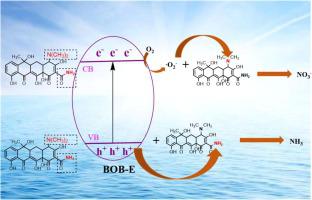Inorganic Chemistry Communications ( IF 3.8 ) Pub Date : 2022-07-19 , DOI: 10.1016/j.inoche.2022.109792 Xiaoqi Chen , Luchen Ai , Peng Ju , Hai Fan

|
N-containing antibiotics wastes with high N content can cause serious environmental pollution. In order to solve the above problem, we prepared the bismuth oxybromide (BiOBr) nanostructures with oxygen vacancies and used as an efficient photocatalysts for the photocatalytic degradation of tetracycline (TC) wastewater to generate ammonia contained reusable water. Results indicated that the BiOBr nanostructures with oxygen vacancies prepared in ethanol solvent showed much enhanced photocatalytic activities, which can degrade TC completely in 1 h and produce 36.38 mg·L−1·g−1 of ammonia eventually. The ammonia conversion rate can reach to 48.53% at the end of the reaction. The obtained ammonia contained water without TC can be reused in agriculture field. The possible mechanism of N element transformation was proposed. This study provides an alternative approach for the photocatalytic generation of ammonia using N-containing antibiotics as nitrogen sources and opens a new perspective for the utilizing and reusing of environmental pollutants.
中文翻译:

含氧空位的BiOBr纳米结构光催化产生含抗生素废水的可重复使用水
氮含量高的含氮抗生素废物会造成严重的环境污染。为了解决上述问题,我们制备了具有氧空位的溴化铋(BiOBr)纳米结构,并将其用作光催化降解四环素(TC)废水以产生含氨可重复使用水的高效光催化剂。结果表明,在乙醇溶剂中制备的具有氧空位的BiOBr纳米结构具有显着增强的光催化活性,可在1 h内完全降解TC,产生36.38 mg·L -1 ·g -1最终的氨。反应结束时氨的转化率可达48.53%。得到的不含TC的含氨水可回用于农业领域。提出了N元素转化的可能机制。该研究为使用含氮抗生素作为氮源光催化制氨提供了一种替代方法,为环境污染物的利用和再利用开辟了新的前景。



























 京公网安备 11010802027423号
京公网安备 11010802027423号